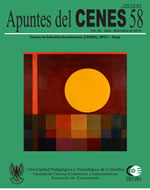Crecimiento económico en Colombia: una aproximación empírica fundamentada en la perspectiva capital humano (1960-2009)

Resumen
El objetivo de este artículo es especificar un modelo empírico basado en los argumentos teóricos, que cuantifique la influencia del capital humano, medido a través de un conjunto de variables que reflejan el comportamiento de la salud y la educación, sobre el resultado del crecimiento económico observado para Colombia, entre los años 1960 y 2009. Realiza un recorrido por la literatura referente al crecimiento económico y el capital humano, representado por la salud y la educación, de tal manera que, con las fuentes de información disponibles en Colombia, realiza una selección de datos que permite la obtención de variables que reflejen y cuantifiquen los canales de trasmisión sugeridos por la teoría existente. Para terminar, especifica un modelo empírico que estima la relación teórica entre el capital humano y el crecimiento económico.
Palabras clave
Crecimiento económico, salud, educación, capital humano.
Referencias
- Aghion, P. & Howitt, P. (2009). The Economics of Growth. Cambridge: MIT Press.
- Aghion, P, Howitt P. & Murtin F. (2010) The Relationship Between Health And Growth: When Lucas meets Nelson-Phelps. NBER Working Papers. Working Paper 15813. Recuperado de http://www.nber.org/papers/w15813
- Arrow, (1962). The economic implications of learning by doing. The Review of Economic Studies, 29(3), 155-173.
- Barro, R. J. (1991). Economic growth in a cross section of countries (No. w3120). National Bureau of Economic Research.
- Becker, G. (1983). El capital humano. Madrid: Alianza.
- Bils, M. & Klenow, P. (2000). Does schooling cause growth? American Economic Review, 90(5), 1160-1183.
- Cleuter D. & Lleras A. (2006). Education and health: evaluating theories and evidence. Nber working paper no. 12352.
- Departamento Nacional de Planeación -DNP- (2009). Gran Encuesta Integrada de Hogares. Recuperado de http://www.dnp.gov.co/
- Departamento Nacional de Estadística -DANE- (2009). Gran Encuesta Integrada de Hogares. Recuperado de www.dane.gov.co
- Echavarría, J. J., López, E., & Misas, M. (2009). Intervenciones cambiarias y política monetaria en Colombia. Un análisis de VAR estructural. Borradores de Economía, 580.
- Gaviria, M. (2007). El crecimiento endógeno a partir de las externalidades del capital humano. Cuadernos de Economía, XXVI (46), 51-73.
- Greco (1999). Grupo de estudios del crecimiento económico colombiano. El crecimiento económico colombiano en el siglo xx: aspectos globales. Bogotá: Banco de la República.
- Groot, W. & Maassen, H. (2007, April). The effect of education on health. Economics of Education Review, 26 (2), 186-200.
- Jiménez G. & Simón, B. (2004). Comparación entre indicadores de capital humano en un modelo de crecimiento económico. Ekonomiaz (57).
- Kaldor, N. (1955). Alternative theories of distribution. The Review of Economic Studies, 83-100.
- Lucas, R. (1988, July). On the mechanics of development planning. Journal of Monetary Economics, 22(1).
- Ministerio de Educación Nacional (2001, sep.). Informe nacional sobre la educación en Colombia. En 46 Conferencia Internacional de Educación, Suiza.
- Ministerio de Educación (2013). (ver comentario pág. 11). Sistema Educativo Colombiano. Recuperado de http://www.mineducacion.gov.co/1621/w3-article-231235.html.
- Mincer, J. (1993). Human capital and economic growthing: studies in human capital. s.l.: Eduard
- Elgar Publishing.
- Montenegro, A. (2007). Series de tiempo. (5 ed.). Bogotá: Pontificia Universidad Javeriana.
- Organización de las Naciones Unidas -ONU-. (2007). World economic situation and prospectives. ONU.
- Organización Panamericana de la Salud (2009). Situación de Salud de las Américas. Indicadores Básicos 2009. Recuperado de: http://new.paho.org/hq/dmdocuments/2009/IB_SPA_2009.pdf
- Instituto Colombiano de Bienestar Familiar (ICBF), Organización de las Naciones Unidas para la Agricultura y la Alimentación (FAO),
- Departamento Administrativo Nacional de Estadística (DANE), Universidad de Antioquia (2008). Adaptación y validación interna y externa de la escala Latinoamericana y Caribeña para la medición de seguridad alimentaria en el hogar - ELCSA Colombia. Recuperado de: http://www.fao.org/publications/es/
- Posada, C. & Rubiano, E. (2007). El crecimiento económico internacional en la segunda mitad del siglo xx. ¿Qué factores lo determinaron? Borradores de Economía, Banco de la República,(445).
- Romer, P. (1994). The origins of endogenous growth. The Journal of Economic Perspectives, 8 (1).
- Sala-I-Martin, X. & Artadi, V. (1999). Apuntes de crecimiento económico. Barcelona: Antoni Bosch.
- Solow, R. (1987). Discurso de aceptación del Premio Nobel. En R. Solow. La teoría del crecimiento. México: Fondo de Cultura Económica.
- Schultz, T. (1972). Recursos humanos. En Human capital: cuestiones de política y oportunidades de investigación. s.l.: National Bureau of Economic Research.
- Uribe, J. (1994, sep-). Inflación y crecimiento económico en Colombia. Borradores de Economía, Banco de la República (1).
- Urrutia, M. & Posada, C. (2007). Un siglo de crecimiento económico. En: J. Robinson & M.
- Urrutia. Economía colombiana del siglo xx, un análisis cuantitativo. Bogotá: Banco de la República.
- Vivas, J. (2006). La capacidad hospitalaria en Colombia. Aspectos de su historia en el siglo veinte. En Crecimiento equidad y ciudadanía. Bogotá: CID Universidad Nacional de Colombia.
- Whalley, J. & Zhao, X. (2010). The contribution of human capital to china’s economic growth NBER working papers. Working paper 16592. Recuperado de http://www.nber.org/papers/w16592
- Weil, D. (2005). Accounting for the effect to health on economic growth. Rhode Island: Brown University, Department of Economics.
- World Bank (2010). World Development Indicators. Recuperado de http://data.worldbank.org/data-catalog/world-development-indicators
